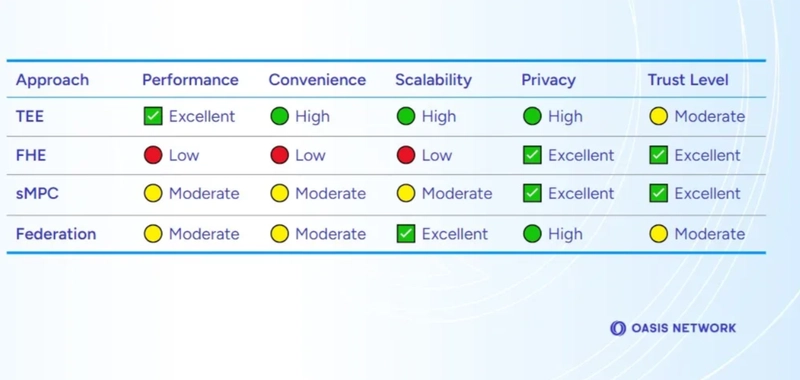Privacy was a blockchain paradox for a long time after the technology was first introduced. But as privacy-preserving solutions emerged and developed, it seemed the missing piece of the puzzle was finally at hand. Trusted Execution Environments or TEEs are one of the most prominent privacy-preserving techniques used today.
TEEs vis-à-vis other privacy solutions
While the suitability of TEEs in complex decentralized and confidential computations makes them preferable compared to Zero Knowledge Proofs or ZKPs, the USP remains the flexibility of TEEs to combine with other privacy tools to produce robust solutions.
Still, the fact remains that while ZKPs and other privacy solutions garnered attention, TEEs remained in the periphery. This has finally changed thanks to consistent awareness built by blockchain protocols like Oasis.
Future is TEEs
Oasis has not only simplified the understanding of TEEs as the black box for smart contract execution, but they have also made TEEs the core component of end-to-end encryption in the confidential computation space.
In addition, Oasis is contributing heavily in researching how TEEs play a crucial role as the optimal infrastructure in building the next-gen web3 and AI.
Why and how remote attestation is integral to TEEs
For the developers familiar with TEEs, remote attestation needs no introduction. It is the mechanism that drives the security aspect of TEEs by enhancing integrity and trust. It works in tandem with reproducible builds that underline the obvious but critical function of verifying that software built from the same source code always produces identical binaries. Combined together, they are basically what makes TEEs tick.
When working with VMs and cryptography, as blockchain protocols do, TEEs can become quickly vulnerable without remote attestation working perfectly. This becomes even more significant in the working of the Runtime Offchain Logic or ROFL framework built by Oasis for developing and deploying TEE-based applications.
Trust but verify is, thus, far easier said than done. Then where do we go from here? Recently, Oasis Foundation Director, Jernej Kos did a deep dive technical analysis on the remote attestation process.
Now that it is verified that TEEs are better and safer with remote attestation, we can all start to believe in on-chain trust for tomorrow's dApps with off-chain performance in focus, too. Start Buidl-ing!




Top comments (8)
This is some awesome alpha! TEEs have often been overlooked in the broader Web3 privacy conversation, so it’s great to see Oasis bringing them to the forefront. The explanation of remote attestation and its role in ensuring trust and integrity was spot on. Combining TEEs with reproducible builds and frameworks like ROFL truly feels like the way forward for secure, high performance dApps.
Nicely written 💯
Remote attestation is absolutely foundational for building trust in TEEs — especially as we move toward more complex applications like confidential smart contracts and off-chain AI logic. Networks like Oasis are already leveraging this to ensure verifiability without sacrificing privacy. Definitely a topic more Web3 devs should explore.
As Web3 evolves, having verifiable yet private computations will be crucial. Exciting to see Oasis leading the charge in this space!
This reminds me of the verifiable AI session where Oasis AI head, Marko engaged in an intriguing and informative discussion with Oasis Labs Director of Engineering, Peter Gilbert on topics like how TEEs are crucial for powering trust.
TEEs have always been a powerful but underappreciated tool in blockchain privacy. Remote attestation is key to making them truly secure and scalable. Oasis pushing this forward is a huge step for Web3 and AI adoption!
Absolutely. Oasis has been pioneering the bringing together of on-chain confidentiality and off-chain verifiability making trust and performance sync together. This is critical to ensure privacy in web3 and AI the smart way. Remote attestation makes this streamlined.
Remote attestation often flies under the radar, but it’s one of the most important pieces in making TEEs actually usable for real-world Web3 and AI applications. Love how Oasis is breaking it down and pushing the conversation forward this kind of foundational work is what’s going to make private, verifiable computation the norm rather than the exception.
Some comments may only be visible to logged-in visitors. Sign in to view all comments.